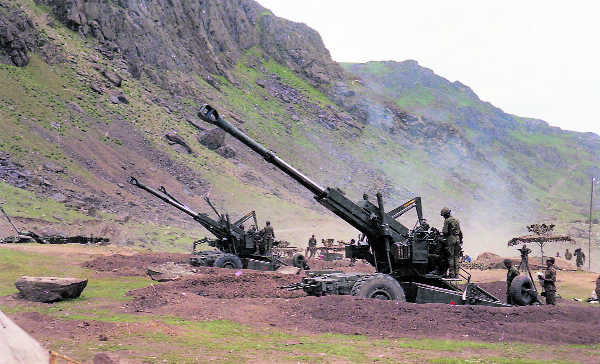
Gunning for victory: A view of the artillery guns during the Kargil conflict. The book celebrates the wartime history of the Regiment of Artillery, the Indian Army's second largest arm
Vijay Mohan
Almost two decades ago the war entered our living rooms. The boom of the big guns echoed in almost all homes across the country as Indians got a firsthand glimpse of the devastating effect of artillery high up in the mountains during the 1999 Kargil conflict, which was when the Regiment of Artillery last went to war.
Over the past centuries, canons and howitzers, and more recently rockets, upgraded and backed by technology, have gained centre-stage at most battles by the virtue of their awesome firepower and inspiring physical presence. As artillery is now the most lethal form of conventional land-based armament, it holds a place of prominence for the military planners, historians and the enthusiast alike.
The first documented record of artillery when gunpowder was used in a battle dates back to January, 1,132, when the Chinese General Han Shizhong of the Song dynasty employed the Huochong hand cannons during the capture of a city in Fujian province on the eastern sea board.
In the Indian subcontinent, historical records point towards the use of big guns by Bahmani Kings during the Battle of Adoni in 1368 and by King Mohammed Shah of Gujarat in the 1400s. Mughal Emperor Babur used it effectively during the Battle of Panipat in 1526 to defeat the much larger army of Ibrahim Lodhi of the Delhi sultanate. Later, the British East India Company raised the first regular company of artillery in 1748, with a small percentage of Indian gunners called Gun Lashkars, Tindals and Serangs. Later, 5 (Bombay) Mountain Battery was raised on September 28, 1827, which became the foundation of the Regiment of Artillery, the Indian Army’s second largest arm, as it exists today.
With a chequered history of campaigns across the world, both in the colonial era as well as post-Independence, the regiment has a rich military heritage and a vast collection of legends and lore. It is some of these that the author, a veteran of the 1962 Indo-China war, Jaffna operations and leader of an expedition to Mount Everest, brings out.
The book has been divided into five parts, covering the life and work of six selected generals from the regiment, eight gallantry awardees, including Capt Umrao Singh, the Regiment’s lone Victoria Cross, four artillery intensive battles, notable Battle Honours awarded, and finally, vignettes of valour that details several episodes and operations where artillery officers had taken over charge of Infantry outfits in a crisis situation during war.
The aim of the book is to celebrate the wartime history of the regiment, of its officers and the men for the benefit of the present generation of Gunners, the posterity and for the veterans to relish the nostalgia and the reminiscences that it may evoke. Towards this, the author has attempted to touch upon the leadership qualities of a few distinguished commanders whom he saw fit to choose from among their peers and the role played by them in defining the regiment’s contours. While the book strictly keeps away from the technical aspects, policy matters and other conceptual or strategic issues concerning the regiment and its ways and capabilities of waging war, it does provide an insight into its past operations and the actions of Gunners when they went into battle.



























